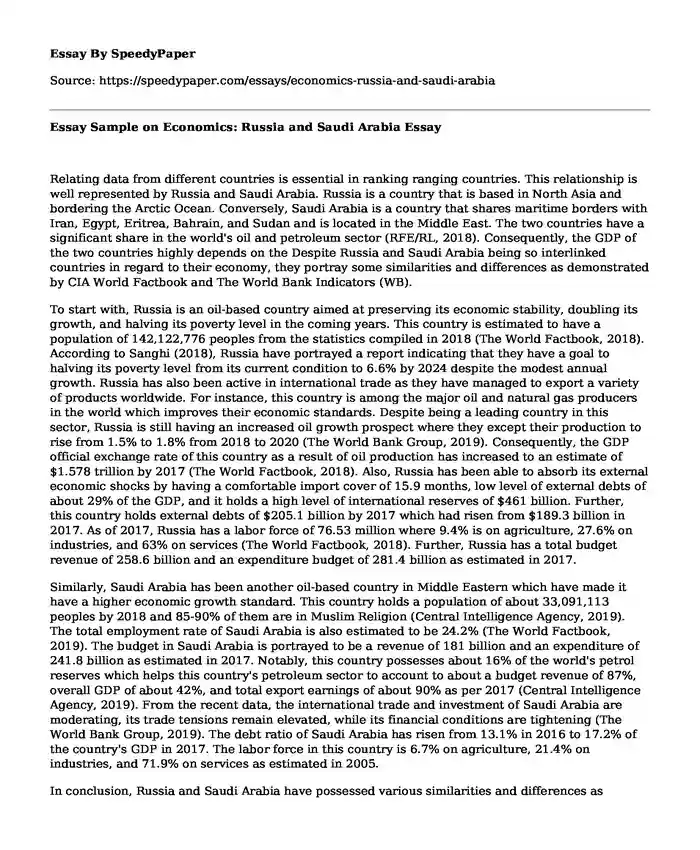
| Type of paper: | Essay |
| Categories: | Economics International relations |
| Pages: | 3 |
| Wordcount: | 765 words |
Relating data from different countries is essential in ranking ranging countries. This relationship is well represented by Russia and Saudi Arabia. Russia is a country that is based in North Asia and bordering the Arctic Ocean. Conversely, Saudi Arabia is a country that shares maritime borders with Iran, Egypt, Eritrea, Bahrain, and Sudan and is located in the Middle East. The two countries have a significant share in the world's oil and petroleum sector (RFE/RL, 2018). Consequently, the GDP of the two countries highly depends on the Despite Russia and Saudi Arabia being so interlinked countries in regard to their economy, they portray some similarities and differences as demonstrated by CIA World Factbook and The World Bank Indicators (WB).
To start with, Russia is an oil-based country aimed at preserving its economic stability, doubling its growth, and halving its poverty level in the coming years. This country is estimated to have a population of 142,122,776 peoples from the statistics compiled in 2018 (The World Factbook, 2018). According to Sanghi (2018), Russia have portrayed a report indicating that they have a goal to halving its poverty level from its current condition to 6.6% by 2024 despite the modest annual growth. Russia has also been active in international trade as they have managed to export a variety of products worldwide. For instance, this country is among the major oil and natural gas producers in the world which improves their economic standards. Despite being a leading country in this sector, Russia is still having an increased oil growth prospect where they except their production to rise from 1.5% to 1.8% from 2018 to 2020 (The World Bank Group, 2019). Consequently, the GDP official exchange rate of this country as a result of oil production has increased to an estimate of $1.578 trillion by 2017 (The World Factbook, 2018). Also, Russia has been able to absorb its external economic shocks by having a comfortable import cover of 15.9 months, low level of external debts of about 29% of the GDP, and it holds a high level of international reserves of $461 billion. Further, this country holds external debts of $205.1 billion by 2017 which had risen from $189.3 billion in 2017. As of 2017, Russia has a labor force of 76.53 million where 9.4% is on agriculture, 27.6% on industries, and 63% on services (The World Factbook, 2018). Further, Russia has a total budget revenue of 258.6 billion and an expenditure budget of 281.4 billion as estimated in 2017.
Similarly, Saudi Arabia has been another oil-based country in Middle Eastern which have made it have a higher economic growth standard. This country holds a population of about 33,091,113 peoples by 2018 and 85-90% of them are in Muslim Religion (Central Intelligence Agency, 2019). The total employment rate of Saudi Arabia is also estimated to be 24.2% (The World Factbook, 2019). The budget in Saudi Arabia is portrayed to be a revenue of 181 billion and an expenditure of 241.8 billion as estimated in 2017. Notably, this country possesses about 16% of the world's petrol reserves which helps this country's petroleum sector to account to about a budget revenue of 87%, overall GDP of about 42%, and total export earnings of about 90% as per 2017 (Central Intelligence Agency, 2019). From the recent data, the international trade and investment of Saudi Arabia are moderating, its trade tensions remain elevated, while its financial conditions are tightening (The World Bank Group, 2019). The debt ratio of Saudi Arabia has risen from 13.1% in 2016 to 17.2% of the country's GDP in 2017. The labor force in this country is 6.7% on agriculture, 21.4% on industries, and 71.9% on services as estimated in 2005.
In conclusion, Russia and Saudi Arabia have possessed various similarities and differences as portrayed by CIA World Factbook and The World Bank Indicators (WB). For instance, the two countries are oil and petrol based which have improved their international trade percentage. However, the two countries are different because Russia has a greater revenue budget than Saudi Arabia despite them having the same expenditure budget of 281 billion. Further, the two countries have ranging debts despite showing an increasing debt ratio from 2016 to 2017. Other differences were as portrayed by their different GDP composition, labor utilization, and their living standards.
References
(2018). Russia, Saudi Arabia Agree to Expand Cooperation on Oil, Gas: Radio Free Europe/Radio Liberty. Retrieved from https://www.rferl.org/a/russia-saudi-arabia-putin-salman-novak-falih-agree-expand-cooperation-oil-gas-matters-opec/29291212.html
Sanghi, A. (2018). Russia Economic Report: The World Bank Group. Retrieved from http://www.worldbank.org/en/country/russia/publication/rer
The World Bank Group. (2019). Saudi Arabia: World Bank. Retrieved from https://data.worldbank.org/country/saudi-arabia
The World Factbook. (2018). Central Asia: Russia - CIA.GOV. Retrieved from https://www.cia.gov/library/publications/the-world-factbook/geos/rs.html
The World Factbook. (2019). Middle East: Saudi Arabia - CIA.gvt. Retrieved from https://www.cia.gov/library/publications/the-world-factbook/geos/print_sa.html
Cite this page
Essay Sample on Economics: Russia and Saudi Arabia. (2022, Dec 08). Retrieved from https://speedypaper.com/essays/economics-russia-and-saudi-arabia
Request Removal
If you are the original author of this essay and no longer wish to have it published on the SpeedyPaper website, please click below to request its removal:
- Mona Lisa
- Essay Example: Environment Versus Economy
- Occupational Safety Essay Sample
- Essay Sample on the China-Africa Relationship
- Education Essay Sample: Early Intervention for Learners with Emotional or Behavioral Disorders
- Principles of Accounting Essay Sample
- Free Essay Example: Appropriate Healthcare Facility
Popular categories




